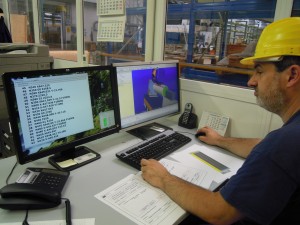Powerful simulation and machining analysis software has allowed an outstanding Italian engineering company to optimize and to improve its production of copper ingot moulds.

It is established at Fornaci di Barga (LU) EM Moulds S.r.l., company that employs about 80 workers and ranks among the world leaders in the production of copper ingot moulds for the continuous steel casting. Mr Giovanni Mori, engineer and production manager of the company explains to us: «Copper ingot moulds are very complex manufactured goods, more precisely “crystallizing moulds” for the continuous casting of steel, which must be manufactured according to the type of plant for which they are requested. They are consumer products that steelworks must order with certain regularity». Products implemented upon design, for customers widespread worldwide that can be both the enterprises that manufacture casting plants for steelworks and steelworks themselves.
A particular history
Five machine tools are presently installed inside the factory at Fornaci di Barga, of which two continuous 5-axis machining centres, on which today the majority of ingot moulds is produced, and three more traditional 3-axis centres. Concerning this, Giovanni Mori comments: «The choice of enlarging the machine fleet with the purchase of two new 5-axis ones, of which the last three years ago, has been radical. It has revolutionized our way of operating because the production on 5-axis machines has allowed us to increase our productivity, to reduce idle times and costs, as well as to improve the quality of manufactured goods». Nevertheless, the passage from 3-axis to 5-axis machines is not a simple operation indeed because it requires a total review of operators’ and programmers’ skills, as well as their will of learning new procedures and methods. This happened also in the case of EM Moulds. It happened then that specialized technicians and workers worked hard, upgrading competence and knowledge. In that process of productive learning and improvement, a fundamental role was played by Roboris S.r.l. (Cascina, PI), enterprise that offers software technologies, training and advice in the field of the automatic programming of NC machine tools and industrial robots. Mr Stefano Giannelli, engineer and Sales Manager of Roboris, confirms: «To explain how much Eureka, our simulation software, could be useful to EM Moulds, we decided to entrust it to its technicians for testing, so that they could test it in-depth, in particular on 5-axis machines». The test was “adjusted” according to specific requirements: they set the machine type, products to be manufactured and targets, proceeding from time to time to the simulation of the machining cycle before implementing the real component. The result was the expected one and in few months the company obtained such advantages and benefits from the use of Eureka that it decided to proceed to make the investment. Today that software is generally used on the two 5-axis machining centres and on one of the three 3-axis machines.
[su_slider source=”media: 603,601,602″]
Safety and optimization
To understand how much the software is really useful, we asked for a further thorough analysis to Stefano Giannelli, who described the product like that: «Eureka is powerful 3D simulation software of stock removal machining, permitting to verify whatever NC programme, inside a complete 3D simulation of the machine tool, before the real execution of the productive programme». It is therefore an effective and innovative computer tool that gives the possibility of avoiding the risks of damaging expensive workpieces, the failures of tools and equipment and even the disastrous collisions with machine parts like the spindle, caused by the always possible errors of operators. The 3D simulation of Eureka, in fact, allows preventively identifying, that’s to say without using the machine, any programming imprecision and remediating to it before starting the production, in other words before it is too late. Besides, the software assures the complete 3D simulation of machining operations, including the stock removal of the material, on any machine tool, with automatic control of collisions and verification of operational limits, of complex ISO programmes and of probing cycles. As far as the specific case of EM Moulds is concerned, Giannelli states: «Besides minimizing productive risks and speeding up the programming phases of machines, the simulator has allowed the company technicians to achieve relevant improvements in the use of the new 5-axis machining centres, helping them in the passage, absolutely not taken for granted and banal, from the 3-axis programming to the 5-axis one. On the other hand, each machine is different and to support in gaining competence and experience in the programming of state-of-the-art machines is one of the most important functions of our software, which is analytical synthesis and verification instrument».
Wide-ranging benefits
Giovanni Mori expresses his deep satisfaction with the results attained thanks to the software use: «The simulation of Eureka allows us to understand with extreme clarity whether our programming is correct or it is necessary to make changes before starting up the machine. This because mathematics, geometry and kinematics visualized on the screen perfectly mirror what would really happen on the machine between workpiece and tool. In that way, we have enormously reduced errors and damaging phenomena like collisions, failures and related machine downtimes». Moreover, Eureka has led to the notable decrease of the implementation time of the “first piece “, that’s to say the test one. In other words, today could you do without software like Eureka? Giovanni Mori’s answer is peremptory and clear: «I really don’t think so ».



